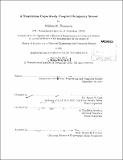A standalone capacitively coupled occupancy sensor
Author(s)
Thompson, William H., M. Eng. Massachusetts Institute of Technology
DownloadFull printable version (22.58Mb)
Other Contributors
Massachusetts Institute of Technology. Department of Electrical Engineering and Computer Science.
Advisor
Steven B. Leeb and Al-Thaddeus Avestruz.
Terms of use
Metadata
Show full item recordAbstract
This thesis presents the design and implementation of a standalone, capacitively coupled, occupancy sensor. Unlike previous iterations, the new sensor is decoupled from the fluorescent lamp. A well controlled, high voltage amplifier and autotransformer are designed as a replacement source and operate over a wide range of output frequencies and amplitudes. The sensor electronics are implemented with active sensing electrodes and resistive and capacitive feedback modes are evaluated for performance. Optimal front end feedback, electrode spacing, and signal source amplitude are explored. The sensor achieves a detection range of 11 feet for occupancy detection, with capacitive measurements down to the attofarad level. The application of the sensor as a material detector, using a linear mixing algorithm, is also found to be feasible.
Description
Thesis: M. Eng., Massachusetts Institute of Technology, Department of Electrical Engineering and Computer Science, February 2013. Cataloged from PDF version of thesis. "September 2012." Includes bibliographical references (pages 169-170).
Date issued
2013Department
Massachusetts Institute of Technology. Department of Electrical Engineering and Computer SciencePublisher
Massachusetts Institute of Technology
Keywords
Electrical Engineering and Computer Science.